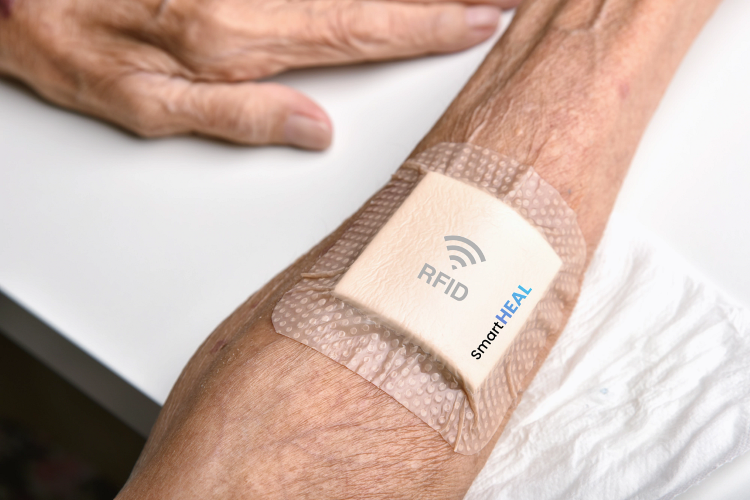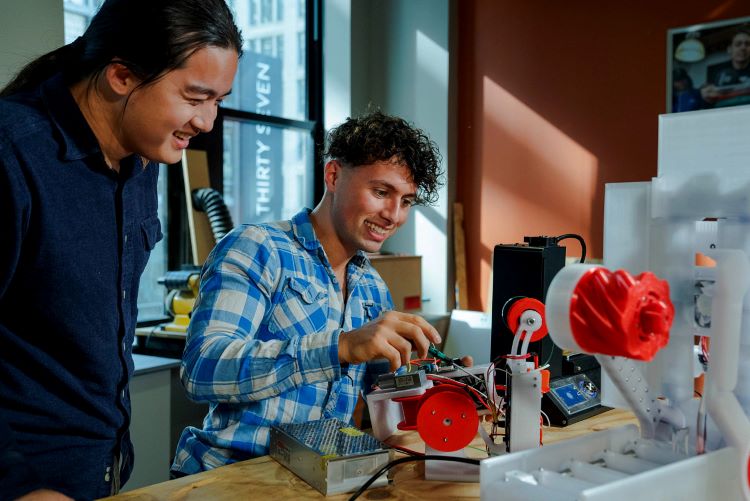Sensory wound dressing scoops James Dyson Award 2022

by IBRAHIM
Sensory wound dressing scoops James Dyson Award 2022
A smart wound dressing and a 3D printer filament made from waste take this year’s top prizes.
The James Dyson Award 2022 global winners have been announced, with a smart sensor designed to measure the pH level of wounds and a machine that recycles plastic bottles into affordable 3D printer filaments winning £30,000 each in development backing.
The annual competition opens every year to students, recent graduates, young designers and inventors who must fulfil the brief of designing something that solves a problem. This year’s international winner and runner up designs responded to problems within the medical sector, while the sustainability winner sought to solve recycling issues in emerging economies.
In addition to the £30,000 prize money for winners, the runners up receive £5000 to take their ideas further towards production in addition to business support from Dyson.
International Winner
SmartHEAL, the smart sensor for dressings which won the international prize, was invented by three students from Warsaw University of Technology in Poland. Tomasz Raczyński, Dominik Baraniecki and Piotr Walter identified that one of the most common mistakes in wound healing is changing dressings too often, which can lead to infections and tissue disruption.
According to the team’s research, 1-2% of the population in emerging countries suffering chronic wounds in their lifetime and wound management also has a negative economic impact on health care providers in wealthier countries such as the USA. Faced with a problem that reaches all corners of the globe, the team’s solution had to be cost-effective and suitable for use in different environments.
Current wound assessment methods include monitoring the colour, smell and temperature of a wound or carrying out expensive lab tests. The SmartHEAL sensor uses Radio-Frequency Identification (RFID) communication systems to monitor the pH levels of a wound, assessing its condition without the need to remove it from the skin. It seeks to provide an accurate and affordable method of analysing data and deciding on treatment.
The team will now work to refine its prototypes, finish testing and start clinical trials. They also wish to obtain a patent for their technology and begin with the commercialisation of SmartHEAL in 2025.
Sustainability winner

After spending some time at a makerspace in Rwanda (a collaborative workspace which encourages innovation through hands-on experimentation), McMaster University Canada students Swaleh Owais and Reiten Cheng saw that many of the locals could not use the space’s 3D printer. The reason for this was the cost of importing the filament that the printer uses into the country.
Another problem that they came across was that there were few resources committed to recycling plastic bottles. The team pursued a solution to both of these problems, resulting in the Polyformer, which is a low-cost machine that turns plastic bottles in 3D printer filament. The 3D printed filament is the material which is melted down by 3D printing machines.
It works by cutting plastic into long strips and feeding them into an extruder, a machine that forces the plastic through a specially designed opening, thermoforming it into 1.75mm filaments. Once it has been through the vents and cooled down, it is wrapped around a spool and ready to use.
The aim of this invention is to foster usage of design infrastructure and create more career opportunities in emerging economies, while also facilitating more recycling in those areas.
Swaleh and Reiten are currently building new Polyformers to be used in partner makerspaces in Rwanda as well as designing new industrial products such as the Polyjoiner – a mechanism that automatically joins multiple strands of printer filament into a long singular piece, benefitting longer print jobs. The Polydryer is another machine in development which draws moisture from the filament producing better print quality, while the Polyspooler is a machine that automatically spools the filament, making it easier to use.
International runner up
Ivvy is a wearable device designed to replace the intravenous drip pole used in hospitals and increase patients’ comfort when receiving infusion therapy treatments. Designed and made by University of Antwerp student Charlotte Blancke, the device features an easy-to-use pump and on-board software, meaning nurses can monitor patients remotely.

With at-home medical care on the rise, Blancke believed that the equipment used should reflect the environment, rather than sticking with the larger, less mobile equipment used in hospitals. She also sought to simplify the complex interface used in existing infusion pumps. Ivvy uses a streamlined interface and intuitive system, which nurses can use to set up the treatment at-home. Patients can track their therapy through an LED strip, display, and sound notifications.
Blancke is planning on further developing Ivvy with the help of industry professionals.
Banner image: Creators of SmartHEAL Tomasz Raczyński, Dominik Baraniecki and Piotr Walter
Recommended Posts

NB invites local designers centre stage for Vineyard Theatre rebrand
February 24, 2023

“AI revolution” will change way design studios look within three years
February 24, 2023

Rbl rebrands ZSL with ecosystem-inspired identity
February 23, 2023

